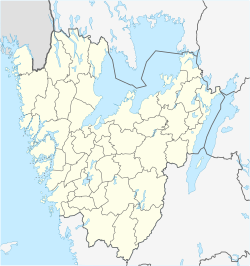Alingsås
| Alingsås | |
|---|---|

Alingsås town square
|
|
| Coordinates: 57°55′48″N 12°31′59″E / 57.93000°N 12.53306°ECoordinates: 57°55′48″N 12°31′59″E / 57.93000°N 12.53306°E | |
| Country | Sweden |
| Province | Västergötland |
| County | Västra Götaland County |
| Municipality | Alingsås Municipality |
| Established | 1619 |
| Area | |
| • City | 12.3523 km2 (4.7692 sq mi) |
| Elevation | 66 m (217 ft) |
| Population (31 December 2010) | |
| • City | 24,482 |
| • Density | 1,982/km2 (5,130/sq mi) |
| • Urban | 38,509 |
| Time zone | CET (UTC+1) |
| • Summer (DST) | CEST (UTC+2) |
| Postal code | 441 xx |
| Area code(s) | (+46) 322 |
| Website | Official website |
Alingsås (pronunciation in Swedish: ![]() Alingsås ) is a locality and the seat of Alingsås Municipality in Västra Götaland County, Sweden. It had 24,482 inhabitants in 2010.
Alingsås ) is a locality and the seat of Alingsås Municipality in Västra Götaland County, Sweden. It had 24,482 inhabitants in 2010.
Geographically the city is situated by the outlet of the small rivulet Säveån into lake Mjörn. Communications are provided by the western main line railroad (Västra stambanan) between and Gothenburg, and by motorway through the European route E20. Next to Alingsås you can also find a small village called Sollebrunn.
Alingsås was founded as inhabitants from the city Nya Lödöse were made homeless as Danish troops burnt it down. Gustavus Adolphus granted Alingsås its Royal Charter in 1619, which makes it older than Västra Götaland's largest city—Gothenburg which was granted its charter in 1621.
Among its historical inhabitants is Jonas Alströmer, who was born in Alingsås in 1685. Alströmer is credited for introducing the potato plant to Sweden. He also established a large scale draper's industry there, which before long became Sweden's largest. However, some too-optimistic calculations, devastating fires and political setbacks finally forced its closure in 1779.
...
Wikipedia


